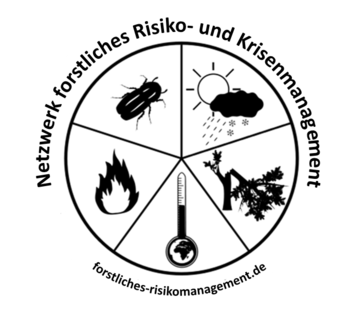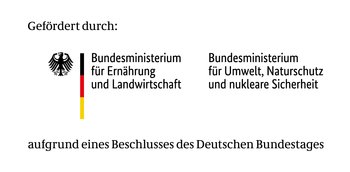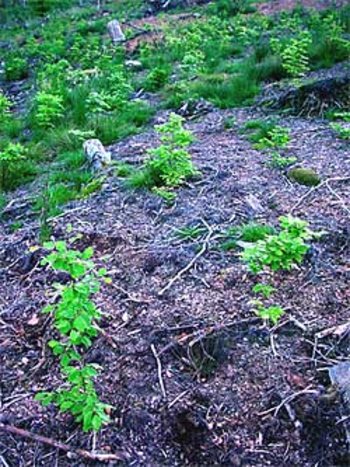Attention. The following options are for your orientation. They are based on experience and knowledge at the time of writing. They must be checked for local actuality in current situations.
Examples from Baden-Wuerttemberg after "Lothar"
The governments of all "Lothar" storm affected countries (Switzerland, France, Germany resp. Baden-Wuerttemberg) responded with promises for storm-affected forest owners. In Baden-Wuerttemberg the following aims were pursued:
- Support of private forest owners (especially small-scale forests of 5-200 ha)
- Stabilisation of the timber market
- Securing of afforestation and regeneration of storm damaged areas.
Subsidies in Baden-Wuerttemberg are divided into financial and organisational/infrastructural respectively institutional subsidies.
A. Financial Subsidies
Fiscal measures:
- Partial remission of income tax for severely affected enterprises according to Section34b EStG of the Income Tax Act;
- Application of reduced tax rates for processing storm damaged timber in future financial years;
- Possibility to subtract expenses of afforestation from current working expenses and;
- Possibilities of the Forest Damage Compensation Act (Link)
Immediate aid in the State of Baden-Wuerttemberg in 2000
For small scale private forests and state forests:
- Direct subsidies for private forests in monetary form
- Establishment of wet storages in small scale private forests, engagement of service companies, reassignment of foresters from other federal states
- Set up of wet storages in state forests
- Provide support service personnel to private forests
- Sale promotion of storm damaged timber
For agriculture:
- Application of the directive "Storm Aid Agriculture"
- Removal of usually uninsured damages
For small sawmills:
Interest-reduced loans to raise storage capacity of raw- and sawn timber as well as for further investments (Federal State Bank, Federal Subsidy Bank)
Immediate measures were deliberately applied only to private forest owners with forest properties smaller than 200 ha. During 2000 and after confirmation of further subsidies through the German Federation and EU, the range of subsidies was expanded.
Fixed amount subsidy
| Pre-carriage and stack aid- a one off subsidy for intermediary transportation to wet or dry storage. There are no transport subsides for timber transportation to buyers | 5.10 €/m3 |
| Wet storage aid- annual subsidy to cover current storage costs (without pre-carriage and investment shares). Can’t be claimed for free storage. | 3.10 €/ m3 (in 1st year 8.20 €/ m3 incl. pre-carriage) |
| Debarking aid- once at dry storage | 2,56 €/ m3 |
| Ground clearing flat rate- for throw/break of stands/wind-slash without usable compact wood (compact wood up to a market value of 511.30 €/ ha (1.000 DM/ha) doesn’t effect the subsidy) | 1,022.60 €/ha resp. 80% of the effective costs |
Partial subsidy
| Investments of timber conservation equipment for wet or dry storages | 40 % of costs (approved); set up of dry stacks according to instructions |
| Repair of forest roads: only for private forests < 200 ha area. | Costs up to 25,565 € or 40 %, above 50 % eligible for financing. |
| Natural regeneration, under planting or afforestation: All kinds of forest ownership. | Only coniferous trees – no subsidy for deciduous tree plantation: 4.090 €/ha Mixed plantation (share of deciduous trees min. 40 %): 2,556 €/ha natural regeneration: 767 €/ha |
| Components of the measures with partial subsidies were part of the subsidy directive "Semi-natural Forestry" and could be applied to (small) private forests up to 200 ha. |
Special loan programs
- Term: three resp. four years (according to estimated max. wet storage duration); repayment ahead of time was possible.
- Interest reduction was 4.5 %.
- The minimum loan was set at 5,113 € resp. 30.70 €/ m3; the final amount was in accordance with the estimated processing costs.
- For private forests with an area of 200 to 1000 ha, a hardship clause was provided: the interest-reduced loan could be used as long as the amount of storm damaged timber exceeded 3 times the annual cut.
B. Institutional Subsidies
Alongside financial measures, institutional subsidies by public (forest) authorities were an important component in coping with "Lothar" storm damages.
The state forest authorities waived fees for private forest owners (according to the private forest ordinance in Baden-Wuerttemberg), for services related to coping with storm damages.
Organisational measures:
- Fast opening of public roads (which were blocked by fallen trees) through personnel of the state forest administration.
- Relocation of forest personnel (civil servants and foresters) from less affected area of the state to storm damage centres, support also provided to non-state forests.
- Temporary increase of forest employees trough fixed-term contracts and the assignment of foresters from other federal states. Also provided to private and communal forests. The increased demand on financial resources was backed up by the federal state.
- Recruitment and supervision of national and European contractors.
- Information sessions held at forest offices with representatives of communal forests, the forestry association and forest owners.
- Intensification of meetings at forest offices with forest rangers and supporting civil servants.
- Informative meetings organised for district foresters by upper forest authorities (Departments of Forestry at the Regional Administrative Authority resp. Centre of State Forest Administration) with the participation of the Forest Research Institute.
Recovery subsidy "Forest"
Requirements:
- Private forest enterprises (with an area under management of 20 to 200 ha)
- Amount of storm damaged timber was at least 40 m3/ha of the entire area under management
- Income between 0 and 92,000 €/year
Contents:
- Subsidy between 102 - 256 €/ha for area under management
- Allowance for 10 years
- No EU co-financing
Subsidy:
- 2.04 Mio. € per year in 2000 and 2001
Measures for processing of storm damaged timber
- Processing within required processing period of all perishable, valuable hard wood for all types of forest ownership.
- Planned delay in processing of timber from coniferous state forests to ensure priority processing, transportation and sale capacities for other forest owners.
- Set up events about work safety when processing storm damages timber for communal foresters and private forest owners.
Measures for timber sale and timber storage
- Deliberate detention of the state forest to offer private and communal forests the possibility to sell their timber at local markets. State timber was placed in storage or brought to distant markets (and less sale revenues were accepted by the state).
- Fast selling of valuable hard wood.
- Depending on market conditions: distance selling of timber in other (federal) states and to Austria, Belgium, Japan, China and France (beech) - leading to new customers for all kinds of forest owners.
- Set up/building of logistics for railway, ship and truck by personnel of the state forest service for all types of forest owners.
- Set up/building of wet storage capacities in the state forest which also took timber from the communal and private forest.
- Development and testing of new storage methods by the state forest services, e.g. wrapping timber in foil
Measures for afforestation
- Free afforestation planning for strongly affected communal forests provided by the department of forestry
Special loan program
As a further measure of support, the State issued two special loan programs and initiated nationwide measures concerning traffic law.
- Loans for cleanup of storm damages on forest areas, purchase of equipment and non-durable assets and cost for contractors (term: 4-6 years, one year of no repayment).
- Loans for purchase of necessary machines, afforestation and backup-investments for storm damaged fixed assets (term up to 20 years, three years of no repayment, maximum amount 0.26 million €)
Measures concerning traffic law
- The federal states were motivated to increase the load limit from 40 to 46 tons and to issues exemptions to the ban of driving on Sundays and public holidays as well as from the holiday travel ordinance.
- The Deutsche Bahn (DB Cargo) were asked to provide capacities for increased timber haulage by train.
State subsidies in 2000
Subsidies according to the jointly issued "Improvement of Agricultural Structure and Coastal Protection".
| Measures | Subsidy |
| Construction of timber storages (wet and dry storages): | Up to 40% of the effective costs. Internal labour can be taken into account for up to 15% of the approved construction sum. |
| Repair of forest roads: | Up to 70% of the repair costs. |
| Afforestation as well as under planting, including natural regeneration in open or over-thinned stands, through seeding or planting (incl. site preparation) and inclusive protection of the plantation against game and securing of the plantation during the first five years: | Up to 50% of the costs for site-caused afforestation of single coniferous tree species, up to 70% for mixed and silver fir stands, up to 85% for deciduous plantations with a share of coniferous trees up to 20%. |
| Clearing of stands without usable material. Mechanic or manual clearing of areas with a large share of wind-slash due to imminent insect infestation. | Up to 80% of the costs but not more than 1,023 €/ha. |
Downloads (in German)
Forest Crises Management Advisory Guide
Back to the main page of the Forestry Crisis Management Advisor Guide: Overview of the different topic collections
Back to the article overview in the: Storm Topic Collection – Coping with Storm Damaged Timber



